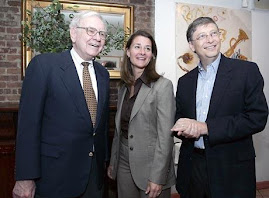If you have been following my write-ups, you would have realised that I had been rather critical about share consolidation action by some listed companies. I had talked about it previously. Basically I take that kind of announcement negatively based on the mindset and investment principles I acquired from Warren Buffett plus my little past experience.
Usually I try to avoid posting other writers or newspaper reports totally on my blog. But today, I like to make an exception, again. On 20 Oct 2007, my highly-recommended and all time favourite analyst, BT Senior Correspondence, CFA Charterholder Ms Teh Hooi Ling posted an article on this topic in Business Times.
In her article, she mentioned that many other analysts around the world, which I am not familiar with, formed negative opinion. Based on Hooi Ling’s own research work, she also came to the same conclusion. No doubt there are exceptions. But take note that these “exceptions” have some other exceptional stories behind that push up their share prices. So in this case, it is not really an apple-to-apple comparison.
To sum up my opinion again before we look into Hooi Ling’s article, company management should focus on improving bottomline. They should leave the share prices to us. If a company proposed to consolidate its share in hope that it can be transformed from a penny stock to a mid-cap, it got it all wrong. The fundamental factor that decide whether a company’s share will be priced like a penny stock or blue-chip lies in SUSTAINABLE PROFIT GROWTH. So the management shouldn’t waste investors’ time and should just focus on the three big words I highlighted.
Here’s the article. Enjoy.
=========================================
Business Times - 20 Oct 2007
Reverse stock splits: boon or bane?
By TEH HOOI LING
SENIOR CORRESPONDENT
At least seven Singapore-listed companies have carried out share consolidation so far this year.
Share consolidation - also known as a reverse stock split - is a corporate action through which a number of shares are consolidated into one.
Various reasons are given by companies for deciding to implement a reverse stock split.
For example, one company said in a statement that prior to consolidation, small movements in its share price represented large percentage movements that resulted in volatility.
'It is anticipated the consolidation will benefit the company and its shareholders by reducing the volatility in the share price,' the company said.
On the Singapore Exchange, the minimum bid for a stock below $1 is half a cent. So a stock trading at one cent can move up or down by half of its value - a 50 per cent swing.
In January this year, Time Watch, after completing a reverse takeover, consolidated 50 shares into one. The company said in a statement: 'Time Watch believes the share consolidation may reduce the fluctuation in magnitude of the company's market capitalisation, lower trading costs for investors and also renew market and investors' interest in the shares.'
In the trading-range hypothesis, it is suggested that stock splits regroup share prices to a preferred price range. An optimal price range is when prices attract investors big and small. Smaller investors may be unable or unwilling to buy shares if the unit price is too high. So companies do a stock split or bonus issue.
If a share price is too low, it is an indication of poor performance and the stock is also viewed as a speculative stock. Institutions tend to avoid such shares. So companies that are willing to court small investors and large institutional ones try to have a stock price that is acceptable to both sets of investors.
Meanwhile, according to the signalling theory, management sends messages to investors via its financial decisions. A bonus share issue or stock split is generally associated with management's confidence in future performance. And so a reverse stock split sends the reverse signal, according to some studies.
Spudeck and Moyer (1985), among others, argue that reverse splits seem to be taken by the market as a strong signal of management's lack of confidence in the future stock prices.
Woolridge and Chambers (1983) even suggest that when a reverse split is impending, investors should sell their shares.
SGX-listed stocks
I've decided to look at the share performance of those stocks on SGX that have been consolidated in the past three years. Of these, only seven have had six or more months of performance since consolidation.
The companies are Integra2000, Lankom, Digiland, Wilmar (formerly Ezyhealth), Hup Soon Global (formerly Twinwood), Delong (formerly Teamsphere) and Time Watch (formerly Wee Poh).
Of these seven companies, four saw their share price underperform the SES All Shares Index by 35 to 86 percentage points in the 12 months leading up to their share consolidation. The exceptions were Ezyhealth, Twinwood and Teamsphere, which saw their share prices shoot up sharply after news of their reverse takeover deals was announced.
In general, reverse stock-split companies did not see their performance improve subsequent to consolidation.
Six months after consolidation, the median excess return of these companies relative to the SES All Shares Index was 45 per cent. The average was -27 per cent.
And 12 months subsequent to reverse stock splits, the median underperformance widened to -58 per cent. The average was -28 per cent.
Based on the limited sample size, it does appear that share consolidation is generally not good news for investors.
Indeed, investors have had an inkling of that. Radcliffe and Gillespie (1979), Woolridge and Chambers, Spudeck and Moyer and Peterson and Peterson (1992) document that significantly negative abnormal returns surround reverse split announcements.
Ho, Nelling and Chen (2005) studied US companies listed on the New York Stock Exchange and Nasdaq that conducted reverse stock splits between 1980 and 2000. They also found that companies that carried out reverse stock splits significantly underperformed the various market benchmarks and stocks with similar characteristics one to three years later.
They said the results suggest that 'reverse-splitting firms are unable to change the pattern of post-split underperformance ... since the reverse stock splitting firms are relatively pessimistic about future prospects'.
There are, of course, exceptions. And a notable exception in Singapore is Wilmar. The stock has performed spectacularly since its reverse takeover of Ezyhealth.
It has been helped by several factors, among them the injections of assets by the Kuok family into the Singapore company, and the interest in biodiesel as a alternative fuel source.
So, for companies that did a reverse-split after a reverse takeover, ultimately, what happens depends on the quality of assets injected into the company.
The writer is a CFA charterholder. She can be reached at hooiling@sph.com.sg
Usually I try to avoid posting other writers or newspaper reports totally on my blog. But today, I like to make an exception, again. On 20 Oct 2007, my highly-recommended and all time favourite analyst, BT Senior Correspondence, CFA Charterholder Ms Teh Hooi Ling posted an article on this topic in Business Times.
In her article, she mentioned that many other analysts around the world, which I am not familiar with, formed negative opinion. Based on Hooi Ling’s own research work, she also came to the same conclusion. No doubt there are exceptions. But take note that these “exceptions” have some other exceptional stories behind that push up their share prices. So in this case, it is not really an apple-to-apple comparison.
To sum up my opinion again before we look into Hooi Ling’s article, company management should focus on improving bottomline. They should leave the share prices to us. If a company proposed to consolidate its share in hope that it can be transformed from a penny stock to a mid-cap, it got it all wrong. The fundamental factor that decide whether a company’s share will be priced like a penny stock or blue-chip lies in SUSTAINABLE PROFIT GROWTH. So the management shouldn’t waste investors’ time and should just focus on the three big words I highlighted.
Here’s the article. Enjoy.
=========================================
Business Times - 20 Oct 2007
Reverse stock splits: boon or bane?
By TEH HOOI LING
SENIOR CORRESPONDENT
At least seven Singapore-listed companies have carried out share consolidation so far this year.
Share consolidation - also known as a reverse stock split - is a corporate action through which a number of shares are consolidated into one.
Various reasons are given by companies for deciding to implement a reverse stock split.
For example, one company said in a statement that prior to consolidation, small movements in its share price represented large percentage movements that resulted in volatility.
'It is anticipated the consolidation will benefit the company and its shareholders by reducing the volatility in the share price,' the company said.
On the Singapore Exchange, the minimum bid for a stock below $1 is half a cent. So a stock trading at one cent can move up or down by half of its value - a 50 per cent swing.
In January this year, Time Watch, after completing a reverse takeover, consolidated 50 shares into one. The company said in a statement: 'Time Watch believes the share consolidation may reduce the fluctuation in magnitude of the company's market capitalisation, lower trading costs for investors and also renew market and investors' interest in the shares.'
In the trading-range hypothesis, it is suggested that stock splits regroup share prices to a preferred price range. An optimal price range is when prices attract investors big and small. Smaller investors may be unable or unwilling to buy shares if the unit price is too high. So companies do a stock split or bonus issue.
If a share price is too low, it is an indication of poor performance and the stock is also viewed as a speculative stock. Institutions tend to avoid such shares. So companies that are willing to court small investors and large institutional ones try to have a stock price that is acceptable to both sets of investors.
Meanwhile, according to the signalling theory, management sends messages to investors via its financial decisions. A bonus share issue or stock split is generally associated with management's confidence in future performance. And so a reverse stock split sends the reverse signal, according to some studies.
Spudeck and Moyer (1985), among others, argue that reverse splits seem to be taken by the market as a strong signal of management's lack of confidence in the future stock prices.
Woolridge and Chambers (1983) even suggest that when a reverse split is impending, investors should sell their shares.
SGX-listed stocks
I've decided to look at the share performance of those stocks on SGX that have been consolidated in the past three years. Of these, only seven have had six or more months of performance since consolidation.
The companies are Integra2000, Lankom, Digiland, Wilmar (formerly Ezyhealth), Hup Soon Global (formerly Twinwood), Delong (formerly Teamsphere) and Time Watch (formerly Wee Poh).
Of these seven companies, four saw their share price underperform the SES All Shares Index by 35 to 86 percentage points in the 12 months leading up to their share consolidation. The exceptions were Ezyhealth, Twinwood and Teamsphere, which saw their share prices shoot up sharply after news of their reverse takeover deals was announced.
In general, reverse stock-split companies did not see their performance improve subsequent to consolidation.
Six months after consolidation, the median excess return of these companies relative to the SES All Shares Index was 45 per cent. The average was -27 per cent.
And 12 months subsequent to reverse stock splits, the median underperformance widened to -58 per cent. The average was -28 per cent.
Based on the limited sample size, it does appear that share consolidation is generally not good news for investors.
Indeed, investors have had an inkling of that. Radcliffe and Gillespie (1979), Woolridge and Chambers, Spudeck and Moyer and Peterson and Peterson (1992) document that significantly negative abnormal returns surround reverse split announcements.
Ho, Nelling and Chen (2005) studied US companies listed on the New York Stock Exchange and Nasdaq that conducted reverse stock splits between 1980 and 2000. They also found that companies that carried out reverse stock splits significantly underperformed the various market benchmarks and stocks with similar characteristics one to three years later.
They said the results suggest that 'reverse-splitting firms are unable to change the pattern of post-split underperformance ... since the reverse stock splitting firms are relatively pessimistic about future prospects'.
There are, of course, exceptions. And a notable exception in Singapore is Wilmar. The stock has performed spectacularly since its reverse takeover of Ezyhealth.
It has been helped by several factors, among them the injections of assets by the Kuok family into the Singapore company, and the interest in biodiesel as a alternative fuel source.
So, for companies that did a reverse-split after a reverse takeover, ultimately, what happens depends on the quality of assets injected into the company.
The writer is a CFA charterholder. She can be reached at hooiling@sph.com.sg



